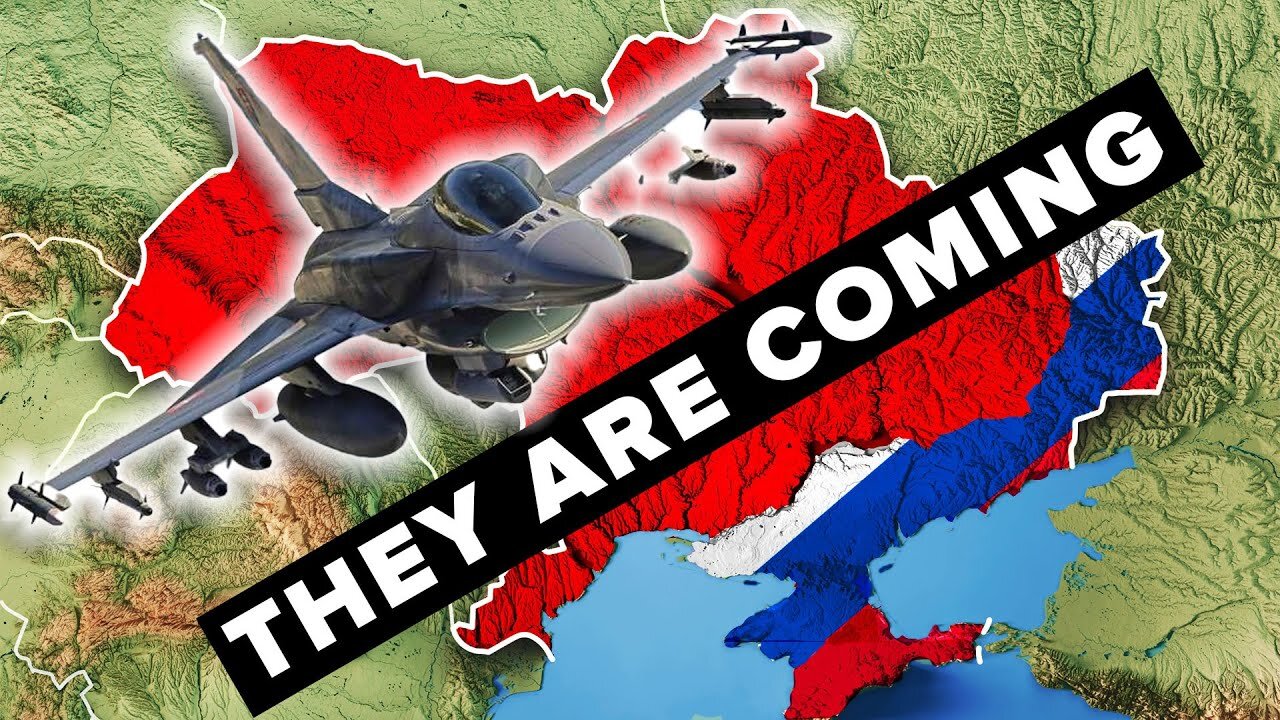Premium Only Content

Why Putin DREADS The F-16
#F16 #UkraineWar #NATO
🇺🇸✈️ Putin dismisses F-16s as a threat, yet NATO's coalition aims to supply Ukraine with these jets. But why does he really fear their arrival? In this video, we explore the significance of F-16s for Ukraine, their impact on the battlefield, and what this means for Russia. Join us as we uncover the strategic dynamics of this crucial development in the Ukraine conflict. 🇺🇦🚀 #F16 #UkraineWar #NATO #Putin #MilitaryStrategy #Geopolitics #Aviation #Russia #Ukraine #Defense #AirForce #Jets #WarUpdate #GlobalSecurity #MilitaryPower #UkraineCrisis #NATOAlliance #EasternEurope #ConflictAnalysis #WarInUkraine
#themilitaryshow
"Russia's Vladimir Putin has long feared the legendary F-16 fighter jet, and for good reason. With its unparalleled maneuverability, advanced weaponry, and proven combat record, the F-16 is a force to be reckoned with. Find out why Putin views the F-16 as a major threat to Russia's military superiority."
0:00
“If they supply F-16s, and they are talking about this and are apparently training pilots, this
0:05
will not change the situation on the battlefield.” Those were the words of Russian President Vladimir
0:10
Putin when speaking to his country’s air force pilots about the possibility of Russia ending up
0:15
at war with NATO in March 2024. The remarks were followed by the chest-puffing that’s
0:21
typical of Putin, as he told the assembled pilots that Russia would destroy any F-16s
0:26
that entered Ukraine, “just as we destroy today tanks, armored vehicles, and other equipment,
0:31
including multiple rocket launchers.” These confident words from a man who’s facing
0:35
up to the seeming fact that Ukraine will finally be receiving F-16s thanks to the efforts of a
0:40
coalition of countries, Norway, Belgium, Denmark, and the Netherlands being among them. These are
0:46
jets that Ukraine has sought for many months as the country is increasingly battered by glide
0:50
bombs launched by Russian fighters from behind the front lines, and their entry into the war will
0:55
give Ukraine more options in the aerial fight. What does that mean for Putin?
1:00
Despite his confidence in public, Putin dreads the arrival of F-16s on the Ukrainian battleground.
1:06
In this video, we’re going to explain why. But before we do, it’s worth digging into the drama
1:11
that has surrounded the introduction of what may be the United States' most famous jet.
1:16
Ukraine’s president, Volodymyr Zelenskyy, has made no secret of his desire to get his hands
1:20
on F-16s. From the early days of the invasion, Zelenskyy has pleaded with his Western supporters
1:26
to deliver the jets to his country, not least because their versatility makes them an excellent
1:30
counter to almost any jet that Russia could use in the fight. It also helps that the F-16
1:36
would be a massive upgrade on the Soviet-era Su jets that Ukraine has been forced to use so far.
1:41
Those pleas seemed to fall on deaf ears. The United States represented the biggest
1:46
hurdle to getting the jets into Ukraine. Though other countries were willing to
1:50
provide their F-16s – as well as the training that Ukraine’s pilots needed to use them – the
1:55
U.S. was wary of allowing them into the conflict. It worried that doing so would create additional
2:00
tensions with Russia, potentially leading to the war stretching beyond Ukraine’s borders. Plus,
2:05
the U.S. argued, the sheer amount of training required to pilot the jets would be so difficult
2:09
and time-consuming that it could distract away from what Ukraine needs to focus on in its fight.
2:14
America held that position until the summer of 2023.
2:18
Finally, Washington gave the go-ahead for Denmark and the Netherlands to send F-16s into Ukraine,
2:24
assuring both that the U.S. would expedite any transfer or approval requests either
2:28
country made to send the jets in. But there would be a catch. The pilots who’d fly the
2:33
jets needed to be trained before they could be sent over. After all, an F-16 can cost anywhere
2:38
between $25 and $70 million – depending on the variant – and that’s not to mention the military
2:44
technology that goes into making one. A poorly trained pilot might crash, or be shot out of
2:49
the sky easier than they should be, leading to the loss of tens of millions of dollars.
2:53
Plus, Russia might learn more than the U.S. wants it to from the downed jets.
2:57
Even so, it was a huge move, with Reuters reporting that a coalition of 11 countries agreed
3:02
to train Ukrainian pilots after the U.S. gave the go-ahead. That coalition grew to 14 soon after,
3:09
showcasing the level of support Ukraine has in its fight against Russia. It also means
3:13
Ukraine could get its hands on powerful jets. The Netherlands alone had 24 F-16s that it was looking
3:19
to phase out by mid-2024 that it could send to Ukraine, along with a further 18 for sale that
3:25
Ukraine may be able to buy. But there’s a problem.
3:28
The U.S. appears to have been right on the money when it said that training Ukrainian pilots to fly
3:32
F-16s would be a long and complicated process. According to Air and Space Forces Magazine,
3:38
senior Pentagon officials believe that Ukraine’s air force will only achieve “initial operating
3:43
capability” with the F16s at the end of 2024, meaning Russia has nothing to fear from them yet.
3:49
If that’s the case, then why does Putin dread the F-16 so much?
3:53
Part of it comes down to the approval of their use in the Ukraine war being a
3:57
sign that the U.S. and its NATO allies are hardening their stance on Russia’s
4:01
invasion. For the first year of the war, NATO nations sent money and military aid, but often
4:06
stopped short of sending the powerful weapons Zelenskyy believed he needed to take on Russia.
4:11
That attitude appears to be changing. Washington’s approval for sending F-16s
4:15
into Ukraine is a sign that it’s taking the Russian threat in Europe more seriously than
4:20
it had earlier in the war. That feeling was intensified in April 2024 when the
4:24
U.S. finally approved a crucial aid bill that will lead to Ukraine receiving $61 billion in
4:30
military funding to help it fight against Russia. It’s likely that this aid – coupled with further
4:35
packages coming from countries like Britain and the Baltic Sea states of Latvia, Lithuania,
4:40
and Estonia – will be enough for Ukraine to maintain a strong defense throughout 2024.
4:45
Just long enough for it to finally be able to unleash F-16s on the battlefield.
4:50
It’s also telling that the four countries that are going to provide Ukraine with
4:54
their F-16s – Norway, Belgium, Denmark, and the Netherlands – are all members of NATO. The same
4:59
goes for most of the members of the now 14-strong coalition that’s currently training Ukrainian
5:04
pilots. Putin has referenced this several times. In the same speech he delivered to
5:08
his pilots about shooting down any F-16s these countries send to Ukraine in Ukraine itself,
5:14
he also appeared to go a little damage control in terms of what that would mean to the NATO
5:18
countries supplying those planes. “We have no aggressive intentions towards these states,” he
5:23
said, going on to claim that the idea that Russia would attack another country was “just drivel.”
5:27
But Europe is starting to take Putin’s actions more seriously.
5:31
Nowhere is that displayed better than in French President Emmanuel Macron’s February
5:36
2024 comments that the possibility of NATO troops entering Ukraine couldn’t be ruled out. The rest
5:41
of NATO was quick to backpedal on that claim, with almost all of the major members saying it wasn’t a
5:46
possibility. But Macron doubled down when speaking to The Economist a couple of months later, telling
5:52
the news outlet that he wasn’t ruling anything out. “We have undoubtedly been too hesitant by
5:56
defining the limits of our action to someone who no longer has any and who is the aggressor,” he
6:01
said when talking about Putin in that article. That’s the sort of talk that Putin doesn’t want
6:06
to hear. And though he will be buoyed by the fact that most other NATO leaders are quick to distance
6:10
themselves from Macron’s comments, there’s still going to be that seed of doubt in his mind. Could
6:15
NATO enter the war in Ukraine? If it did, that would pit Russia against major European powers,
6:20
including France, Britain, and Germany, as well as force it to face the United States.
6:25
Perhaps Putin doesn’t just fear the entry of F-16s into Ukraine. He may also fear what they
6:30
represent – the rest of Europe (as well as the United States) waking up to his ambitions for the
6:35
continent and becoming ever more willing to stand against him. Putin’s comments about not attacking
6:40
other countries, and certainly not NATO members, are seen in a new light in this context. It’s why
6:46
he’s been so careful to point out that any F-16s sent to Ukraine will be shot down “in Ukraine.”
6:52
Putin doesn’t want to spark a wider war. And he certainly doesn’t want a host of
6:56
countries that have stronger militaries than Ukraine to pay more attention to what he’s doing.
7:01
Now, let’s switch focus from what the F-16s – and the increasing cooperation of a coalition
7:05
of countries that are sending those planes and training pilots could mean for Putin’s war – and
7:10
toward what the F-16 brings to the battlefield. It would be a massive upgrade on the jets that
7:15
Ukraine currently has available. At the beginning of the war,
7:18
Ukraine’s aerial arsenal mostly consisted of outdated Soviet planes. Politico says that it
7:24
had 71 Su-27 and Mig-29 fighters, along with 31 Su-25 attack aircraft and a small fleet of Su-24M
7:33
bombers. All capable planes, but all Russian-made and understood, as well as being a few generations
7:40
behind the planes and jets that Russia was able to bring to the battlefield. And though Ukraine
7:44
has done a good job of defending itself from Russia’s attempts to establish aerial dominance,
7:48
that stock of older planes is being whittled down. Politico reported that it
7:52
had just 78 combat-capable aircraft in 2024. The F-16 is faster and more versatile than
7:59
these jets, meaning Ukraine would be able to use it to conduct operations that it couldn’t before.
8:04
Operations such as those involving AGM-88 High-Speed Anti-Radiation Missiles,
8:09
or HARMs. The United States has provided Ukraine with these missiles since August 2022,
8:15
with their supersonic speeds and HE fragmentation warheads making them dangerous precision missiles
8:21
to use against Putin’s forces. The problem for Ukraine is that they haven’t been able to get
8:26
the most out of their HARMs. The missiles were made for use with the F-16CJ, while
8:30
Ukraine has been forced to deploy them from old Soviet jets for which they were never designed.
8:35
National Interest points out that this means the utility of Ukraine’s
8:39
HARMs has been “dramatically limited.” That’s because HARMs work by identifying
8:44
the electromagnetic radiation that radar arrays broadcast, using that radiation for
8:49
their targeting purposes. Ukraine’s problem so far is that its outdated jets haven’t been
8:54
capable of properly operating in contested or Russian-controlled airspace because Russia’s
8:59
planes could shoot them out of the sky. With F-16s in their arsenal, Ukraine could enter contested
9:05
airspace using planes designed to utilize HARMs. That would spell bad news for Russia’s air defense
9:10
equipment – such as its own jets – which instantly become targets for HARMs as soon as they power
9:15
up and start transmitting radar waves. Right now, Ukraine’s fighters can only
9:20
use HARMs in what National Interest called a “pre-briefed” mode. In other words, the
9:24
missile is programmed to reach a specific target area before being fired from a long distance
9:29
by one of Ukraine’s fighters. The issue here is that firing from long distances gives Russia a
9:34
chance to spot the missiles before they arrive, allowing them to power down the radar-sending
9:39
targets the missiles are supposed to destroy. That won’t be a possibility if Ukraine
9:44
can use F-16s to get in close. When that happens, such as it will
9:48
when Ukraine has F-16s, Ukrainian pilots can instead use the “self-protect” and “target of
9:54
opportunity” operational modes that HARMs are designed to use. The former uses the F-16’s
9:59
onboard radar warning receiver to identify radar waves as their broadcast,
10:04
passing that data to the HARM so it can hone in on the location transmitting those waves and secure
10:10
its target. Then, it can hit regardless of whether or not the target powers down its radar equipment
10:15
when the HARM is incoming. As for “target of opportunity,” that system alerts the pilot
10:19
when a radar array powers up, triggering them to launch their HARMs at it in a more reactive mode.
10:25
Either way, having F-16s means Ukraine’s HARM missiles become more useful. And that
10:30
spells bad news for Russia when it’s coordinating its own aerial assaults.
10:34
More bad news comes from the fact that F-16s will be capable of operating in Russian territory.
10:40
Why? They could allow Ukraine to prevent Russia
10:42
from conducting assaults with its glide bombs. In the early months of the Ukraine war, Russia’s
10:48
aerial offensive was far from as effective as it could’ve been. Ukraine’s anti-air defenses
10:53
helped to protect it from low-flying craft looking to drop bombs or support ground troops,
10:57
with Radio Free Europe reporting that Moscow has likely lost at least 100 fixed-wing
11:02
aircraft since the war began. A change of tactics was needed.
11:06
And that change came through the use of glide bombs.
11:09
Also referred to as KABs, glide bombs are repurposed Soviet-era weapons that have proven
11:14
remarkably effective in Russia’s campaign against Ukraine. They typically come in two varieties – a
11:20
1,100-pound version called the FAB-500 and a 3300-pound variant dubbed the FAB-1500. Both
11:27
are deadly, capable of reducing entire structures to rubble if they hit their targets. However,
11:32
they’re also outdated. The bombs have no advanced guidance systems, which meant that
11:37
Russia would have had to drop them from behind enemy lines in their previous incarnations.
11:41
But Russia came up with a clever way to utilize these bombs.
11:45
By attaching small wings to the FAB-500 and FAB-1500, Russia gives these massive bombs
11:50
the ability to glide through the air over long distances. That allows the bombs to be
11:55
launched from Russian planes well behind the war’s frontlines, meaning the planes
11:59
carrying the bombs aren’t at risk of being taken down by Ukraine’s anti-air defenses. The older
12:04
tech in these bombs also plays into Russia’s hands as it makes them much harder to target
12:09
using modern missiles and defenses. The impact of this innovation
12:12
has been devastating for Ukraine. Glide bombs played a huge role in Russia’s
12:17
taking of Avdiivka, as a Ukrainian soldier named Egor Sugar highlighted in a post on X just days
12:23
before Ukraine was forced to abandon the city. “These bombs completely destroy any position,”
12:28
he said. “All buildings and structures simply turn into a pit after the arrival of just one
12:33
KAB. And they drop 60-80 pieces on us in one day.” Russia is able to drop so many of its glide bombs
12:39
for two reasons. First, the wings they’re now attaching to the bombs serve as crude guidance
12:44
systems. That means they can travel toward the vicinity of a target and cause massive damage,
12:49
even if they don’t score a direct hit. Second, those wings allow Russia to launch glide bombs
12:54
with no danger of them being stopped by Ukraine’s anti-air defenses – all are
12:58
launched from the safety of Russian territory. The only real defense Ukraine could have against
13:03
these bombs is to send its fighters into Russian territory to shoot down or chase
13:07
away the Russian jets launching the bombs. That isn’t possible with the planes Ukraine
13:11
has now – they’re too outdated compared to what Russia has and certainly aren’t fast
13:15
enough to stop the glide bombs being launched. The arrival of F-16s changes all of that.
13:21
For context, Russia has generally been using its Su-35 aircraft to launch glide bombs. The
13:26
Conversation reported that it started outfitting these jets with equipment to launch FAB-500s
13:31
in March 2023, and it’s been running saturation attacks with the bombs ever since. The problem for
13:37
Ukraine is that the Su-35 is faster than the older Sus and Migs that Ukraine has. So, if Ukraine were
13:44
to send its jets to try and chase off the Su-35s behind the front lines, they’d find themselves
13:49
outpaced to the point where the Su-35s could still drop their bombs and even come back to fight the
13:55
older Sus and Migs Ukraine sends. That’s not even to mention that Ukraine’s older jets would have
14:00
to deal with Russia’s anti-air defenses. A counteroffensive against the glide bomb
14:04
launching Su-35s was practically impossible. With F-16s in its arsenal, Ukraine will finally
14:10
have a plane that’s capable of competing against the Su-35. Granted, the Su-35 is
14:16
faster – it can reach speeds of Mach 2.5 versus the Mach 2 that the F-16 can reach. However,
14:21
that’s balanced by the Su-35 is larger, making it easier to see on radar and, crucially, easier to
14:27
pick out of the skies with a long-range missile. So, possibilities start opening up for Ukraine.
14:33
With its F-16s, it will be able to better engage Su-35s in the air,
14:37
forcing them to retreat both because the F-16 can almost keep up with the Su-35 and because
14:43
the missiles fitted into the F-16 – such as the previously mentioned HARMs – could down the Su-35.
14:48
There are also suggestions that the Su-35 isn’t as good as Russia claims it to be.
14:54
That’s according to a former U.S. Air Force Lieutenant Colonel named Dan Hampton. He
14:58
highlights that the Su-35’s wingspan is over 15 feet wider than the F-16s – contributing to it
15:04
being easier to pick up on radar – and that the plane is a “typical Russian machine.” According
15:09
to Hampton, that means it “looks good at air shows,” but is actually not a great example
15:13
of a multirole jet. Perhaps that’s why Russia has been relegated to using it to launch glide
15:18
bombs from its own territory rather than using its Su-35s to dominate the skies over Ukraine.
15:23
Perhaps Putin knows all of this. If Hampton’s claims about the Su-35 are true,
15:28
the arrival of F-16s doesn’t just mean that Ukraine reaches parity with Russia in terms
15:33
of its multirole fighters. It might have a jet that’s actually better than the one Russia is
15:38
using right now, even though there’s a 30-year gap between the first F-16 being commissioned and the
15:43
Su-35 first taking to the skies. Speaking of radar, the F-16
15:48
comes with advantages there, too. According to Kelly Grieco, who works
15:51
at The Stimson Center as a senior fellow, Russia is able to spot Ukraine’s MiG-29s at a far further
15:57
distance than Ukraine is capable of spotting Russia’s aircraft. Presuming the F-16s Ukraine
16:02
receives are equipped with the AN/APG-66 radar, it will be far more capable of spotting Russian
16:08
planes, meaning Ukraine can respond to aerial assaults much faster. That will prove useful when
16:13
chasing down the Su-35s dropping glide bombs, even if it won’t be enough for Ukraine to fully close
16:19
the radar disadvantage it faces against Russia. So, the F-16 doesn’t necessarily completely
16:25
outclass anything that Russia can deploy over the skies of Ukraine.
16:28
But it is much better than what Ukraine has now and it opens up a wealth of tactical and
16:33
strategic options that weren’t available to Ukraine before. The proper use of HARMs – and
16:38
other long-range missiles – will be a boon for Ukraine, with the F-16 also being capable
16:43
of taking on the Su-35s Russia has used to such great effect in recent months.
16:47
The one bright spot Putin can take from all of this is that Ukraine won’t have many F-16s, even
16:53
when it’s received every plane that other nations have pledged to it. According to The New York
16:57
Times, Ukraine may start with as few as six of the planes – once their pilots are trained – meaning
17:02
they will have to be very choosy when it comes to deployment. The same newspaper also reports
17:07
that around 45 F-16s have been pledged to Ukraine – less than half of the 120 Su-35s
17:14
that Russia had at the beginning of the war. Putin clearly dreads the F-16s because they make
17:18
Ukraine more versatile as both an attacking and defensive force in the air. But their importance
17:24
shouldn’t be overstated – 45 F-16s doesn’t turn the tide completely in Ukraine’s favor when Russia
17:30
has so many more planes at its disposal. Still, there’s another aspect of
17:34
the F-16 that Putin fears: It’s capable of carrying nukes.
17:39
Putin mentioned this during his speech to his Air Force personnel in March 2024,
17:44
and it had been highlighted by Russia almost a year before. In June 2023, Reuters reported that
17:50
Russia’s Minister of Foreign Affairs – Sergei Lavrov – told soldiers during a speech at the
17:54
Dushanbe based in Tajikistan that “we must keep in mind that one of the modifications
17:59
of the F-16s can ‘accommodate’ nuclear weapons.” He’s not wrong.
18:04
Some variations of the F-16 have been altered to make them capable of
18:07
carrying America’s B61 nuclear gravity bomb. A bomb that has been with the U.S. military
18:13
since 1968, the B-61 has undergone about a dozen iterations since its introduction. The most recent
18:19
version – the B61-12 – measures 12 feet and weighs 825 pounds, with B-2A, F-15E, F-16C/D,
18:29
F-16 MLU, PA-200, F-35, and B-21 models all being capable of launching it. It is designed
18:37
to have four selectable explosive yields: 0.3 kilotons (kt), 1.5 kt, 10 kt, and 50 kt, with
18:45
its advanced inertial navigation system giving it the ability to strike a target with an accuracy of
18:50
approximately 30 meters CEP.. It’s a terrifying weapon.
18:55
And, if used, could change the complexion of the entire war.
18:59
Of course, there’s a caveat to the Russian fear of the F-16’s nuclear capabilities – Ukraine
19:04
doesn’t have nuclear weapons. On top of that, the only country that could supply the B-61s Ukraine
19:09
would need for its F-16s – the United States – would absolutely not do that unless Russia
19:14
launched a tactical nuclear strike of its own. So, perhaps Putin doesn’t dread the F-16s because of
19:19
their nuclear threat in the immediate sense. Instead, he may dread them because they give
19:24
Ukraine a nuclear option of its own should Putin ever follow through on his repeated
19:28
threats to use tactical nukes in Ukraine. Putin rightfully dreads the arrival
19:33
of F-16s in his war against Ukraine. The planes give Ukraine more tactical and
19:38
strategic options thanks to their advanced weapons systems and the fact that they serve as a useful
19:43
counter to the Su-35s Putin is using for his glide bomb campaigns. He also dreads their nuclear
19:49
capabilities, even if the possibility of Ukraine getting its hands on B-61s is practically nil.
19:55
But perhaps most importantly, he dreads the F-16’s arrival in Ukraine because that arrival
20:00
is symbolic of Europe and the United States taking him more seriously as a threat. Not
20:05
just to Ukraine, but to other countries should he win the war. Putin’s constant mentions of how
20:10
ridiculous the thought of him attacking another country is may not be indicative of his actual
20:15
plans. Instead, it may be an attempt to pull the wool over the rest of Europe’s collective
20:19
eyes at a time when Europe seems to be waking up to the threat he could pose beyond Ukraine.
20:25
But what do you think? Will the arrival of F-16s in Ukraine be a game-changer or does Russia have
20:31
everything it needs to take on Ukraine’s limited supply of these multirole jets? Do you think
20:36
the United States might start sending F-16s into Ukraine itself once its pilots have been trained
20:41
appropriately? Tell us your opinions in the comments and thank you for watching the video.
20:46
Now go check out Why F-16s in Ukraine Will END
20:49
Russian Air Force or click this other video instead!
-
 LIVE
LIVE
2 MIKES LIVE
1 hour ago2 MIKES LIVE #158 Government Shutdown Looms and Games!
343 watching -
 LIVE
LIVE
The Big Mig™
5 hours agoVeteran, Patriot, Leader, Author Allen West joins The Big Mig Show
2,010 watching -
 DVR
DVR
The Amber May Show
22 hours agoBloated CR Failed | What Did The View Say Now? | Who Kept Their Job At ABC| Isaac Hayes
1.09K -
 59:29
59:29
State of the Second Podcast
4 days agoAre We Losing the Fight for Gun Rights? (ft. XTech)
6.03K3 -
 1:00:10
1:00:10
The Nima Yamini Show
3 hours agoTragedy in Germany 🇩🇪 Suspected Terror Attack at Christmas Market – LIVE Updates from Germany
15K22 -
 10:52
10:52
Evenout
3 hours ago $0.45 earnedTIME TRAVELLING ON THE ESCALATOR TWIN PRANK!
6.31K2 -
 5:43:44
5:43:44
Scammer Payback
7 hours agoCalling Scammers Live
78.4K12 -
 LIVE
LIVE
Barry Cunningham
4 hours agoWATCH LIVE: James O'Keefe, Gen. Michael Flynn,, Byron Donalds, PBD & More At AmericaFest!
810 watching -
 2:00:10
2:00:10
Twins Pod
7 hours agoYouth Pastor Confronts People Possessed By DEMONS! | Twins Pod - Episode 44 - Drew Hernandez
44.5K13 -
 1:37:40
1:37:40
The Quartering
7 hours agoShutdown Watch, Biden Dementia Bombshell, Madison Shooter Had An Accomplice & Much More!
83.5K39